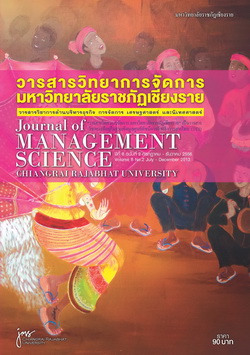Patterns and Procedures for Poverty Reduction of the Disadvantaged People in the Rural Societies of Upper Northern Region
Main Article Content
Abstract
The purpose of this study, based on the qualitative and quantitative research, aimed to explore the disadvantaged people’s poverty, factors affecting their poverty, and patterns and procedures for their poverty reduction, as well as to find out the on-going strategies for the implications of the patterns and procedures for the disadvantaged people’s poverty reduction in the rural societies of the upper northern region. For data collection, a questionnaire was conducted with 400 out of the 1,892 respondents from 14 villages were randomly sampled. These included members of community funds located in Muang Na Sub-district, Chiang Dao District, Chiang Mai Province. In addition to the SWOT analysis, a group discussion was carried out for 15 community leaders specializing in their local wisdom, and effective poverty management. Also, the descriptive data were statistically analyzed through using percentage, frequency distribution, and multiple regression analysis. The findings of the study were as follows: 1. The disadvantaged people’s poverty was caused by the outnumber of family, ethnical divides, the limitations of educational competition, health deterioration, no effective life planning management, agriculturists’ fewer amounts of their monthly incomes, their lack of skill competence, no part-time job - taken allowances, no utilization of water resources for their drinking and public utilities, the leasing of land properties for their farming, no accessibility of fund services, no evidences for mortgage securities, no certificates of ownership, debts with its expensive rates of interests, no social welfares, and their life and safety menace; 2. In terms of the 3 social factors affecting the disadvantaged people’s poverty, it was stated that non-gross profits, no savings, no permanent assets with its underestimated prices, and no establishment for community funds were influenced on their cost savings, whereas their no accessibility of fund services, no opportunities in their information services, no electricity and waterworks services, life menace, and no social welfares were all induced in terms of the disadvantaged people’s political, economic, and social opportunities. Also, their outnumber of private debts spent for non-targeted purposes, no part-time allowances, no participation in their membership caused the disadvantaged people’s financial situations; 3. In terms of the disadvantaged people’s patterns for their poverty reduction, it was stated that the establishment of ownership-authorized community funds with their effective savings management, stock-raising, depositing and crediting services, trainings on the implications of the philosophy of economic sufficiency and allurement-decreasing, the continuation of effective poverty management, their productivity with reduction of life-earning expenses, socialization-based paradigm shifts, and additional after-project activities served for their participation and networking collaboration with their other participants were all implemented for their poverty reduction and management; 4. In terms of the on-going strategies for the SWOT analysis and implications of the patterns and procedures for the disadvantaged people’s poverty reduction in the rural societies of upper northern region, it was also suggested that other different and financial institutions’ funds were not only sponsored, but the involved accounting management-specialized participants’ and staff’s growth strategy was also promoted for their practical implications of the philosophy of economic sufficiency, as well as their career training services, and their better understandings of community strengthening development in cooperation with their community fund members.
Article Details
Views and opinions expressed in the journal do not necessarily reflect those of the editors.


